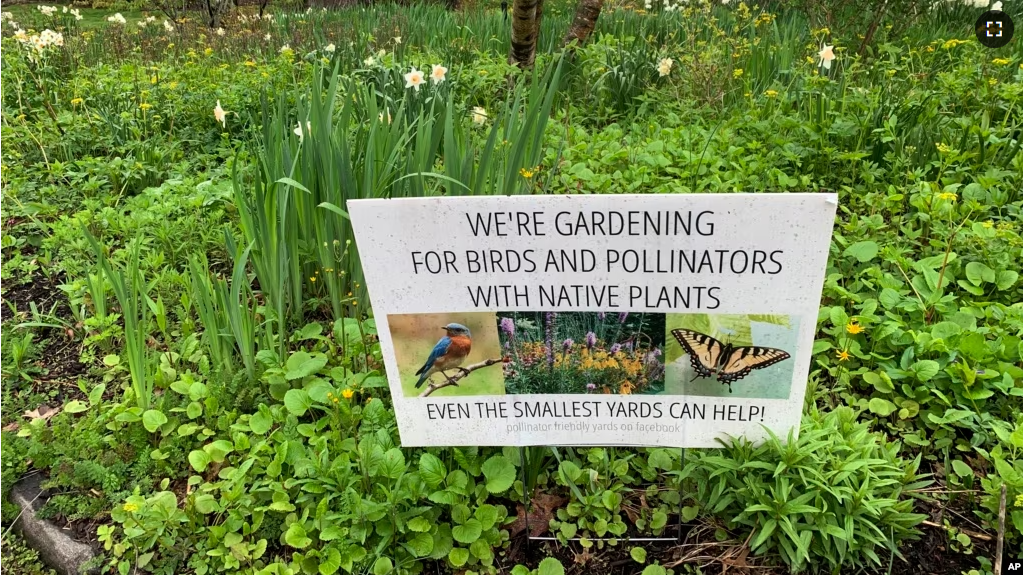A wildlife and insect expert who urges people to create gardens with native plants is now bringing children into the effort.
Doug Tallamy has become a leading supporter for returning native plants and trees to places, so they can support birds, bees and other wildlife. He is urging people to push for parks, playgrounds, schools and colleges, hospitals and office buildings, golf courses and even airports to join in spreading native plants.
Tallamy’s new book is called Nature’s Best Hope: How You Can Save the World in Your Own Yard. It is aimed at middle schoolers and was released earlier this month in time for Earth Day. The book follows Tallamy’s influential book from 1999 for all readers: Nature’s Best Hope: A New Approach to Conservation that Starts in Your Yard.
He hopes the new book will carry its message into classrooms around the country.
“The idea is that kids are the future stewards of our planet,” he said in an interview with The Associated Press.
“I get contacted by kids all the time, and this is stuff you can do and actually see results, ” he said.
Little things can make a big difference.
“You don’t have to worry about the entire planet. Just do something about the little piece of the planet that you can do something about. That’s really motivating for parents as well as kids,” he said.
The book for young people lists easy changes that children can make at home to create better habitats for insects and birds.
The book includes easy projects like building a “bee hotel” out of an empty metal can and pieces of paper. Or you might want to cover window wells so little creatures do not get trapped in them.
“Or just plant an acorn. It’s free and easy and you can watch it grow, and it makes a big difference,” Tallamy says.
He imagines a future of many little pollinator-friendly spaces — a growth of gardens and public spaces — all loosely linked to form a “Homegrown National Park.”
Tai Montanarella helps lead school and out-of-school programs for The New York Botanical Garden. She teaches kindergarten through high school kids about native plants. She said spreading the word that Americans can do things at home to improve the environment is important.
“At the heart of Tallamy’s book is the observation of plants, and the interaction between plants and birds and insects. It underscores the connectivity of our food web and of society,” she said.
“Kids sometimes feel a greater sense of urgency and call to action than adults,” she continued. “Many of these ideas seem sensible and practical for kids, while they can be a heavier lift for adults sometimes.”
Tallamy is a professor at the University of Delaware. He starts his new book by asking readers to take a few minutes to look closely at their yards.
Did you see “a single animal — a bird, a bug, a snake, a mammal of any size — hop, fly, flutter, slither, crawl, or creep past?” he asks, “You’re right. You don’t. But you should.”
“Nature is everywhere. That’s a good thing because human beings like you and me wouldn’t last a day without it,” Tallamy writes. “That’s what this book is about — how to create a yard that is a real part of the natural world.
“The kind of yard where, if you look closely,” Tallamy writes, “something is moving.”
I’m Caty Weaver.
The Associated Press reported this story. Caty Weaver adapted it for VOA Learning English.
__________________________________________________________________
Words in This Story
steward –n. a man whose job it is to take care or protect property, such as land
interview –n. a discussion in which someone asks questions and another person answers them
stuff –n. a general term for things
entire –adj. all of something
motivate –v. to cause someone or a group of people to want to do something
habitat –n. a place where plants and animals naturally grow and live
pollinator –n. an animal such as a bee that spreads pollen which fertilizes plants
underscore –v. to draw attention to something
mammal –n. a kind of animal that feeds milk to it’s you, has hair and certain ear bones
